
Rainbow Teak sandstone was selected for the exterior facade of the Kierland Financial building in Phoenix, AZ, for its coloring, which blends with the natural surroundings. The material was quarried and fabricated by TAB India of Jaipur, India, and supplied through its U.S. branch, Amsum & Ash, Inc. of Minneapolis, MN.
Sitting in the heart of Arizona’s desertscape, the Kierland Financial building in Phoenix, AZ, was designed to reflect its natural surroundings. Those involved with the project desired a stone for the exterior facade that would exhibit the warm tones found in the region’s sandy grounds and nearby mountains. As a result, Rainbow Teak sandstone, which was quarried by TAB India of Jaipur, India, and supplied through its U.S. branch Amsum & Ash, Inc. of Minneapolis, MN, was chosen to clad the 180,000-square-foot commercial building.
“We wanted to use local materials as much as possible to make it look like an Arizona building,” said Artin Knadjian, AIA, Senior Associate Partner at Langdon Wilson in Phoenix, which served as the architect for the project. “The Rainbow Teak sandstone met the look of local materials, which were either more expensive or not to the liking of our client.”
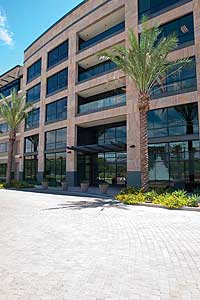
“We wanted to use local materials as much as possible to make it look like an Arizona building,” said Artin Knadjian, AIA, Senior Associate Partner at Langdon Wilson in Phoenix, which served as the architect for the project. “The Rainbow Teak sandstone met the look of local materials, which were either more expensive or not to the liking of our client.”
But in the end, the soft movement of the Rainbow Teak sandstone met the criteria for the project. The blend of beige, red, gold and gray found in each piece creates an aesthetically pleasing look for the building. The color shade also ties in well with the colors of the surrounding environment.
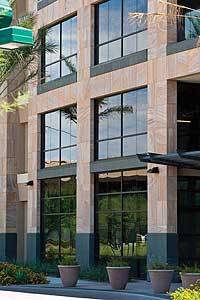
In addition to Rainbow Teak sandstone, black granite from China was employed for the wainscot base. The dark-colored stone, which was given a flamed finish, was a stark contrast to the lighter tones of the sandstone.
“It was a tough challenge to get the veining how the architect wanted it,” said Gupta. “There is a lot of movement in the stone. In the end, we were able to make it work and supplied all of the stone on time.”
Knadjian also added that the most challenging aspect of the project regarding the stonework was coordinating all of the details with the quarry and fabrication plant. “We wanted to make sure that all the detailing was properly done and that there was no delivery/critical path issues coming from India,” he said.
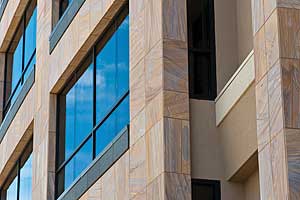
The soft movement of the Rainbow Teak sandstone, which consists of a blend of beige, red, gold and gray, creates an aesthetically pleasing look for the building.
“The black granite was part of the color scheme and the overall look,” said Knadjian. “The cost was appropriate to what we were looking for.”
The installation
In total, 15,000 square feet of Rainbow Teak sandstone was supplied for the project. Sizes included 1 foot, 6 inches x 3 feet, 2 x 3 feet and 2 feet, 6 inches x 3 feet. All of the stone pieces were secured to the structure with a handset application. Individual anchors were used to fasten each stone tile, according to Mark Andrews, Chief Commercial Estimator at Sun Valley Masonry, Inc. in Phoenix, which completed the stone installation for the project.
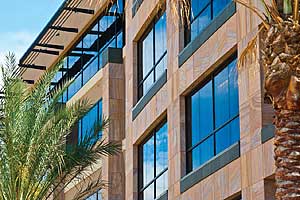
All of the stone pieces were secured to the structure with a handset application that included using individual anchors to fasten each stone tile.
According to Andrews, there were a few challenges during the installation, but for the most part everything went smoothly. “The most challenging aspect was that the radial entry soffits required close coordination between the other trades - particularly metal stud framing and glazing,” he said.
Design and construction of the Kierland Financial building took under two years to complete, according to the architect. The stone installation was finished in approximately three months.
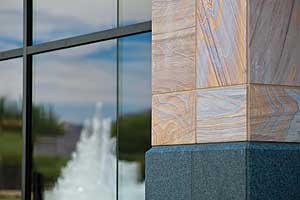
For the installation, each stone had a specific numbered location on the project which corresponded to the setting drawings provided by Sun Valley Masonry.
Sidebar: Kierland Financial Building
Phoenix, AZArchitect: Langdon Wilson, Phoenix, AZ
Stone Quarrier/Fabricator: TAB India, Jaipur, India (sandstone)
Stone Supplier: Amsum & Ash, Inc., Minneapolis, MN (sandstone)
Stone Installer: Sun Valley Masonry, Inc., Phoenix, AZ
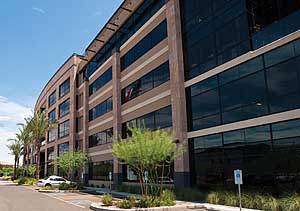
With 16 workers on the jobsite for most of the duration, it took approximately three months to complete the stone installation.
